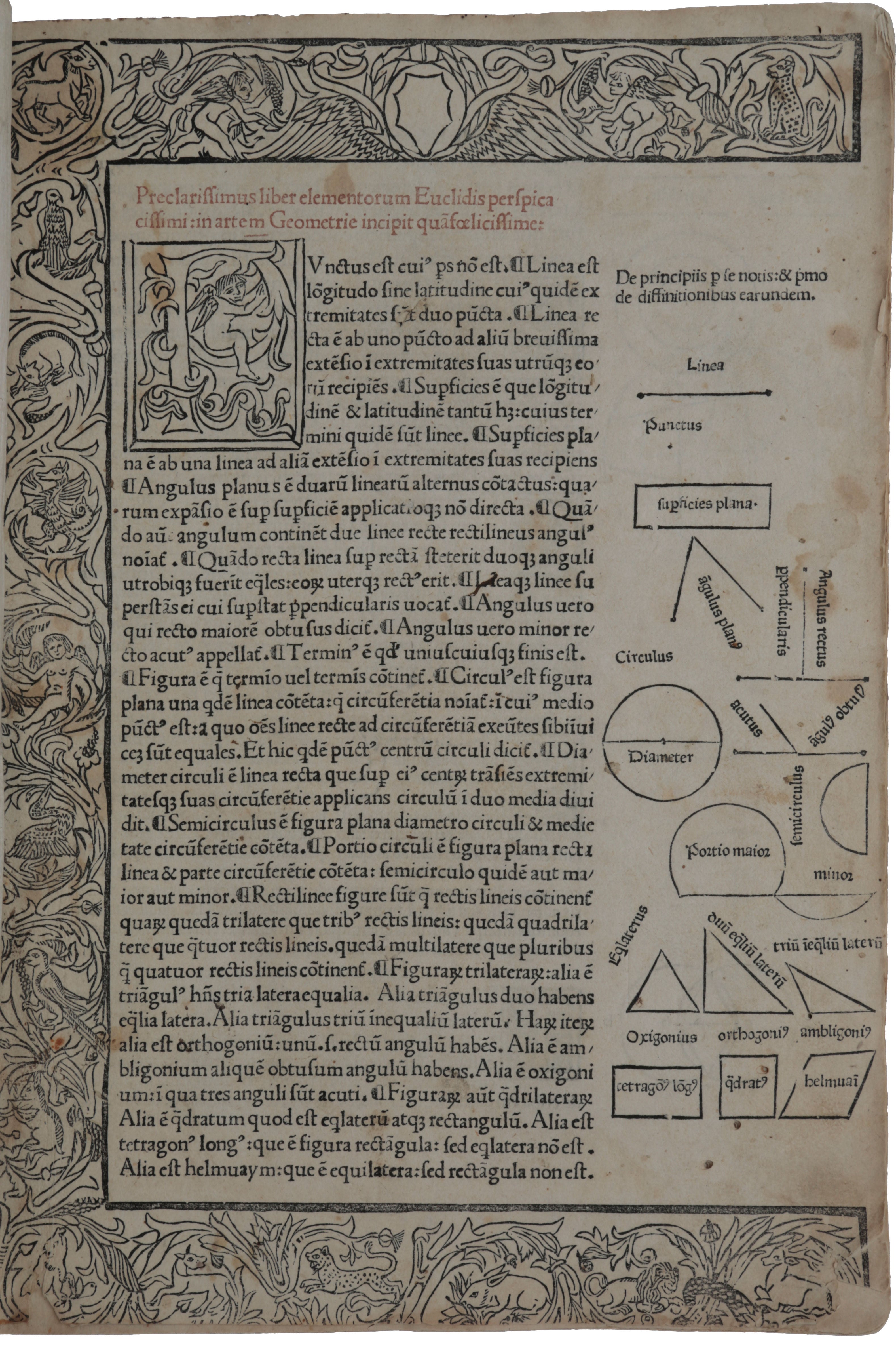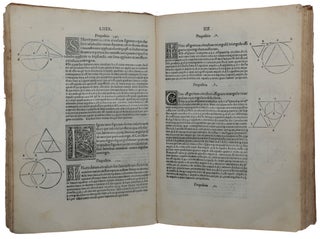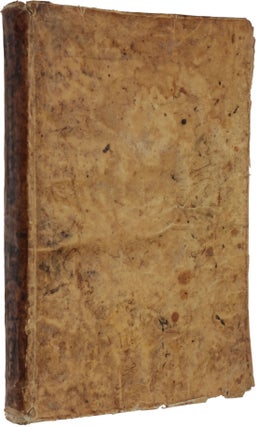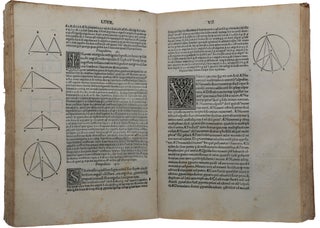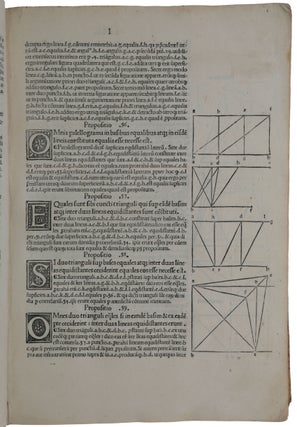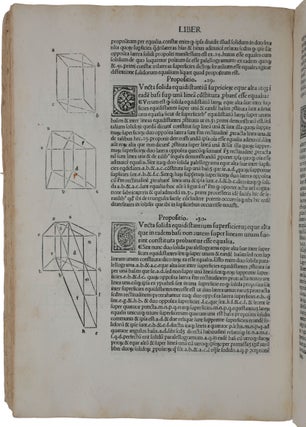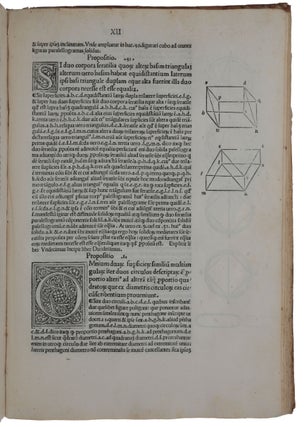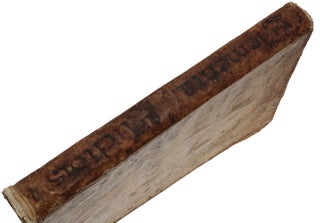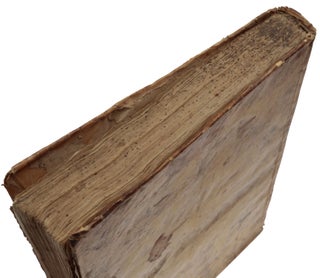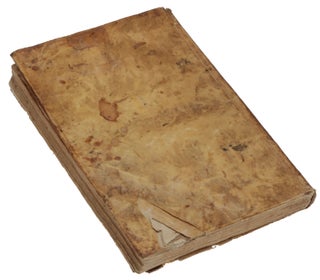Preclarissimus liber elementorum Euclidis perspicacissimi: in artem geometrie incipit quamfoelecissime.
[Colophon:] Vicenza: Leonardus de Basilea and Gulielmusde Papia, 1491. A fine copy, with wide margins, of the second edition of the “oldest mathematical textbook still in common use today” (PMM), “much more uncommon than the edtio princeps” (Thomas-Stanford, p. 5), and especially rare in an unrestored contemporary binding as here. This book “has exercised an influence upon the human mind greater than that of any other work except the Bible” (DSB). Euclid’s Elements is the only work of classical antiquity to have remained continuously in print, and to be used continuously as a textbook from the pre-Christian era to the 20th century. It is the foundation work not only for geometry but also for number theory. Euclid’s Elements of Geometry is a compilation of early Greek mathematical knowledge, synthesized and systematically presented by Euclid in ca. 300 BC. Books I-IV are devoted to plane geometry, Book V deals with the theory of proportions, and Book VI with the similarity of plane figures. Books VII-IX are on number theory, Book X on commensurability and incommensurability, Books XI-XII explore three dimensional geometric objects, and Book XIII deals with the construction of the five regular solids. The text is the standard late-medieval recension of Campanus of Novara, based principally on the 12th-century translation from the Arabic by Adelard of Bath. In fact, Adelard left three Latin versions of Euclid. Campanus’s text is a free reworking of earlier Latin translations, mainly Adelard’s second version (an abbreviated paraphrase), with additional proofs. This text was printed more than a dozen times in the late-15th and 16th century. This second edition is much rarer than the edition princeps (Venice: Ratdolt, 1482), which it closely follows. It only omits the dedication to the Doge of Venice. The border of the incipit page is composed of animals, birds and cupids, instead of the arabesque ornament. Otherwise, it is a page-for-page reprint using roman, instead of gothic type. The method used to produce the very large number of complex geometrical diagrams is still a matter of scholarly debate. Although traditionally described as woodcuts, it is probable that printer’s “rules” were used, i.e., thin strips of metal, type high, which were bent and cut and adjusted and set into a substance that would hold them (and pieces of type) in place. ABPC/RBH record the sale of only two copies in the last 30 years. “Born ca. 300 BC in Alexandria, Egypt, “Euclid compiled his Elements from a number of works of earlier men. Among these are Hippocrates of Chios (flourished c. 440 BC), not to be confused with the physician Hippocrates of Cos (c. 460–375 BC). The latest compiler before Euclid was Theudius, whose textbook was used in the Academy and was probably the one used by Aristotle (384–322 BC). The older elements were at once superseded by Euclid’s and then forgotten. For his subject matter Euclid doubtless drew upon all his predecessors, but it is clear that the whole design of his work was his own … “Euclid understood that building a logical and rigorous geometry depends on the foundation—a foundation that Euclid began in Book I with 23 definitions (such as “a point is that which has no part” and “a line is a length without breadth”), five unproved assumptions that Euclid called postulates (now known as axioms), and five further unproved assumptions that he called common notions. Book I then proves elementary theorems about triangles and parallelograms and ends with the Pythagorean theorem … “The subject of Book II has been called geometric algebra because it states algebraic identities as theorems about equivalent geometric figures. Book II contains a construction of “the section,” the division of a line into two parts such that the ratio of the larger to the smaller segment is equal to the ratio of the original line to the larger segment. (This division was renamed the golden section in the Renaissance after artists and architects rediscovered its pleasing proportions.) Book II also generalizes the Pythagorean theorem to arbitrary triangles, a result that is equivalent to the law of cosines. Book III deals with properties of circles and Book IV with the construction of regular polygons, in particular the pentagon. “Book V shifts from plane geometry to expound a general theory of ratios and proportions that is attributed by Proclus (along with Book XII) to Eudoxus of Cnidus (c. 395/390–342/337 BC). While Book V can be read independently of the rest of the Elements, its solution to the problem of incommensurables (irrational numbers) is essential to later books. In addition, it formed the foundation for a geometric theory of numbers until an analytic theory developed in the late 19th century. Book VI applies this theory of ratios to plane geometry, mainly triangles and parallelograms, culminating in the “application of areas,” a procedure for solving quadratic problems by geometric means. “Books VII–IX contain elements of number theory, where number (arithmos) means positive integers greater than 1. Beginning with 22 new definitions—such as unity, even, odd, and prime—these books develop various properties of the positive integers. For instance, Book VII describes a method, antanaresis (now known as the Euclidean algorithm), for finding the greatest common divisor of two or more numbers; Book VIII examines numbers in continued proportions, now known as geometric sequences (such as ax, ax2, ax3, ax4, …); and Book IX proves that there are an infinite number of primes. “According to Proclus, Books X and XIII incorporate the work of the Pythagorean Thaetetus (c. 417–369 BC). Book X, which comprises roughly one-fourth of the Elements, seems disproportionate to the importance of its classification of incommensurable lines and areas (although study of this book would inspire Johannes Kepler [1571–1630] in his search for a cosmological model). “Books XI–XIII examine three-dimensional figures, in Greek stereometria. Book XI concerns the intersections of planes, lines, and parallelepipeds (solids with parallel parallelograms as opposite faces). Book XII applies Eudoxus’s method of exhaustion to prove that the areas of circles are to one another as the squares of their diameters and that the volumes of spheres are to one another as the cubes of their diameters. Book XIII culminates with the construction of the five regular Platonic solids (pyramid, cube, octahedron, dodecahedron, icosahedron) in a given sphere” (Britannica). “The significance of Euclid’s Elements in the history of thought is twofold. In the first place, it introduced into mathematical reasoning new standards of rigor which remained throughout the subsequent history of Greek mathematics and, after a period of logical slackness following the revival of mathematics, have been equaled again only in the past two centuries. In the second place, it marked a decisive step in the geometrization of mathematics … It was Euclid in his Elements, possibly under the influence of that philosopher who inscribed over the doors of the Academy ‘God is for ever doing geometry,’ who ensured that the geometrical form of proof should dominate mathematics. This decisive influence of Euclid’s geometrical conception of mathematics is reflected in two of the supreme works in the history of thought, Newton’s Principia and Kant’s Kritik der reinen Vernunft. Newton’s work is cast in the form of geometrical proofs that Euclid had made the rule even though Newton had discovered the calculus, which would have served him better and made him more easily understood by subsequent generations; and Kant’s belief in the universal validity of Euclidean geometry led him to a transcendental aesthetic which governs all his speculations on knowledge and perception. It was only toward the end of the nineteenth century that the spell of Euclidean geometry began to weaken and that a desire for the ‘arithmetization of mathematics’ began to manifest itself; and only in the second quarter of the twentieth century, with the development of quantum mechanics, have we seen a return in the physical sciences to a neo-Pythagorean view of number as the secret of all things. Euclid’s reign has been a long one; and although he may have been deposed from sole authority, he is still a power in the land” (DSB). HC *6694; GW E107; BMC VII, 1033 (IB. 31729); Goff E-117; IGI 3723; Sander 2606; Klebs 383.2; Steck, p. 41; Thomas-Stanford 2. See Dibner 100, Horblit 27 and PMM 25 for the first edition.
Chancery folio (299 x 207 mm), 136 leaves (without either blank). Roman types 7:114 (propositions) and 6:88 (proofs), gothic type 10:74 (reference letters of diagrams). 50-51 lines (proofs) and headline. Heading on a2r printed in red. Very fine three-sided woodcut animal border and matching initial P on a2r, numerous woodcut and type-rule diagrams in the margins (a2 lower corner slightly chipped with minor loss to printed border, four (reducing to one) small wormholes to outer margins a2-c4, occasional marginal foxing, marginal staining to last few leaves). Contemporary vellum, manuscript title on spine (some staining and contemporary pen trials on covers, tear to lower cover with some loss). Preserved in a modern red-morocco-backed clamshell box.
Item #5194
Price: $95,000.00

